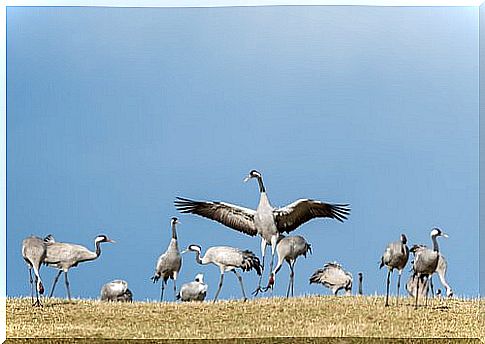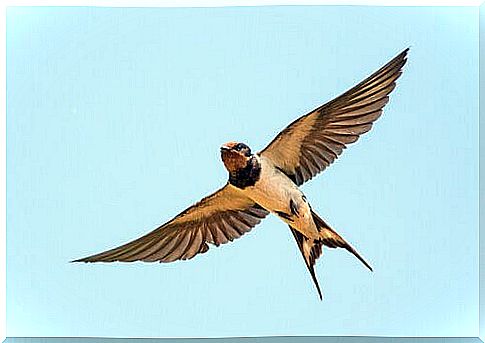6 Migratory Birds You Must Know

Animal migrations are one of the most curious behaviors in wildlife. Among the animals that migrate, the highlight is the migratory birds that can travel great distances.
These generally do not adapt to extreme cold, and tend to travel to warmer areas during the winter months. There are many different species of migratory birds. Stay with us to get to know them better.
Migratory Birds: Common Crane
Not everyone knows that the common crane ( Grus grus ) is one of the migratory birds that travels the most. But the truth is that this animal breeds in northern Asia and Europe, and then spends the winter in milder climates, in southern Eurasia and even in Africa.
This animal breeds in swamps in cold countries such as Ukraine, Finland, Sweden and Russia, where there are up to 100,000 specimens. Later, when summer ends, he emigrates to North Africa. However, many populations remain in southern Europe, especially in Spanish lagoons such as Gallocanta.
During migrations up to 400 individuals gather. However, once the migration ends, they separate as they are not very sociable animals. The common crane migrations have already been mentioned by Aristotle and even in the Bible.
the swallow
The swallow is one of the smallest migratory birds and, in terms of its habitat, it usually lives in open fields and settles in barns, stables and even houses.
It reproduces in the entire Holoarctic region, that is, in practically all of Eurasia and North America, only absent in the deserts and in the more northern regions. Unlike its relative, the common crane, it is quite typical of rural areas.
It will then winter in countries closer to the south, such as India and a large part of Africa and South America. It can be seen in countries such as Hawaii and Greenland. The swallow can perform extensive routes, which include wintering in South Africa and breeding in the UK.

the fusel
The fusel (Limosa lapponica), also known as the chalreta, is a very particular bird, with a beak that stands out due to the shape of a needle. It is included among the great multitude of water birds, but few can match it in terms of migration.
In this sense, the fusel is an outstanding bird: there are no other migratory birds that travel 11,000 miles without stopping. This animal flies from Alaska to New Zealand, which is why over the past few months it has gained a lot of weight to support such a journey, as does salmon. Specifically, he spends over a week flying without interruption.
arctic swallow
Also called the arctic tern, it is a seabird that breeds in the Arctic. The crossing of these migratory birds is legendary as it is the largest regular migration that exists in the animal kingdom. The arctic swallow crosses virtually the entire planet Earth to reach Antarctica.
Adding back and forth, this allows the arctic swallow to travel 80,000 kilometers a year and live two summers a year. Thus, this species almost always lives “bathed” in sunlight, thanks to the perpetual day it usually lives.
the dark wall
This species is distributed throughout the Atlantic, Pacific and between the South Indian Ocean. When its breeding season ends, around April, it migrates to subarctic waters in summer.
This species migrates individually and can cover distances of 900 kilometers per day. Their migrations are not the longest, although they are a respectable 14,000 kilometers.
However, specimens traveling from Alaska to New Zealand do so for nearly 70,000 kilometers. This, together with their great longevity, which is around 50 years, means that some specimens have migrated eight million kilometers over their lifetime.
pebble tree
This species is an aquatic bird that lives in the Arctic. His migration routes are not entirely precise, but it seems that every southern summer he travels to “Tierra del Fuego”, where he rests and feeds well for a few months.
There is a specimen of this bird that broke several records and represents one of the great curiosities of birds. After more than 20 years of ringing, this bird has traveled the equivalent distance from our planet to the moon. Although it is estimated that other species have traveled greater distances, the B95 record (this is the animal’s name) is unique in history.









